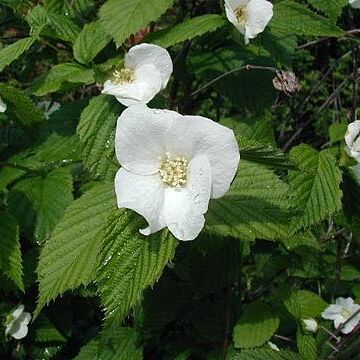Shrubs, ?spreading?, rounded, 5–20(–30) dm. Stems 5–20+, widely arcuate; bark gray; long shoots moderately branched; unarmed; glabrous. Leaves deciduous, cauline, opposite; stipules deciduous, linear, margins entire; petiole present; blade ovate, 4.5–10 cm, membranous, margins flat, sharply doubly serrulate, ?teeth sometimes stipitate-glandular along distal margins?, surfaces sparsely sericeous. Inflorescences terminal ?on vernal, leaf-bearing branches?, flowers solitary; bracts absent. Pedicels present. Flowers 30–45 mm diam.; epicalyx bractlets 4, ?slender?; hypanthium shallowly cupped, 4–6 mm diam., exterior sericeous-strigose; sepals 4, spreading, ovate to oblong-ovate; petals 4, ?spreading-ascending?, white, ovate-orbiculate, ?base short-clawed, apex rounded?; stamens 30–60 (± in 4 clusters), much shorter than petals; torus thickened, dome-shaped, surrounding and overtopping ovaries, constricted below styles, leaving styles free, distally crenulate or 4-toothed; carpels 4, glabrous, styles lateral; ovules 2. Fruits aggregated nutlets (appearing as dry drupelets), 1–4, ?black?, ovoid-globose, compressed, 6–9 mm; ?exocarp thin; mesocarp dry, thin; endocarp thick, cartilaginous?; hypanthium persistent; sepals persistent, reflexed. x = 9.
More
Shrubs deciduous. Buds with imbricate scales. Leaves opposite; stipules free, linear, membranous, caducous; leaf blade simple, ovate, margin sharply doubly serrate. Flowers terminal on branchlets, solitary, bisexual. Hypanthium saucer-shaped, flat. Sepals 4, in 2 pairs, imbricate, leaflike, with 4 epicalyx segments in-between. Petals 4, opposite sepals, white, base shortly clawed. Stamens numerous, in several series. Disk crowning hypanthium, large, thick, dissected into 4 lobes. Carpels usually 4; ovary covered by 4 lobes of disk at flowering; ovules 2, pendulous, 1 abortive; style terminal, exserted, filiform; stigma capitate. Fruit a drupe; epicarp smooth, dry. Seed 1, obovoid; cotyledons plano-convex, adaxially 3-veined. x = 9.

